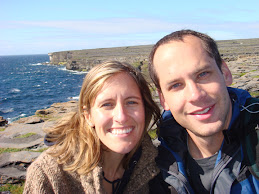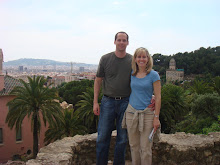
This weekend we took a day trip down through the Shannon region (primarily County Clare), about 1.5 hours south of Salthill, to visit a few of this region's top tourist destinations.
http://www.shannonheritage.com/
QUIN ABBEY
During our search for our first stop, Knappogue Castle, we passed through the quaint town of Quin and stumbled upon its amazing Quin Abbey ruins. The Abbey was built in the 15th century in the tradition of Irish Franciscan Monasteries, but it was built on the ruins of a Norman castle fortress that stood there in the late 13th century.
http://www.nd.edu/~ikuijt/Ireland/Sites/mdonnel2/
KNAPPOGUE CASTLE
Knappogue Castle was built in 1467 by Sean MacNamara, and is a magnificent example of a medieval tower house and boasts a vast, walled garden. It must have been closed for the season, sadly, so we didn't get to go inside the castle or the garden.
http://www.shannonheritage.com/Attractions/KnappogueCastleWalledGarden/
CRAGGANOWEN
Craggaunowen - the Living Past - is Ireland’s prehistoric park created by a famous archaeologist to mimick life in Ireland in ancient times. There were hardly any tourists there, as we went in mid-October, so we got to tour Craggaunowen Castle, the Crannog, the Ring Fort, the ‘Brendan Boat’ and other points of interest without the crowds. There are these really cool sheep, Soya sheep, that look like goats upon arrival; the breed is a pre-historic breed, and the posted sign by the pin said that ancient breeds were smaller and more similiar to goats. The medieval tower castle at Craggaunowen dates back to 1550. We got to watch a boy inside demonstrate wool cleaning and spinning it into yarn on an old spindle. The Crannog is a commune built on water; people lived in the huts. The Brendan Boat is a leather hulled boat built by Tim Severin who sailed across mid-Atlantic re-enacting the voyage of St. Brendan and the early Christian monks reputed to have discovered America centuries before Columbus. At the Ring Fort, we exited through the Soutterrain - an underground passage designed primarily as food storage areas; souterrains maintain a constant temperature of around 4 degrees no matter how hot it gets on the surface. They could also be used as places of refuge during attacks on the Ring fort.
http://www.castlesgardensireland.com/craggaunowen-project.html
Here's a cool video on Cragganowen:
http://www.youtube.com/watch?v=W0dvbI9ksHY
BUNRATTY CASTLE AND FOLK PARK
Bunratty is considered Ireland’s premier visitor attraction - it includes the 15th century Bunratty Castle and 19th century Bunratty Folk Park. Bunratty Castle is considered the most complete and authentic medieval fortress in Ireland and is fully furnished. Built in 1425, it was restored in 1954 to its former medieval splendour and now contains mainly 15th and 16th century furnishings, tapestries, and works of art which capture the mood of those times. There are four, skinny spiral staircases, giving access to the various floors. It was a slow day from a tourism standpoint, and we were glad. It would be impossible to get up and down the spiral staircases during the high season, we think. There are medieval banquets held in the castle twice per night April-October.
Within the grounds of Bunratty Castle is Bunratty Folk Park, which recreates 19th-century life in Ireland. Set on 26 acres, the park includes 30 buildings in a "living" village and rural setting, which spread out at the foot of the castle's massive walls, much in the way that the cottages and crofts of old would have clustered around its base. The folk park was a little too touristy for us, but it was a hoot to see a pregnant donkey on the grounds and chickens running around the little cottages.
http://www.shannonheritage.com/Attractions/BunrattyCastleFolkPark/




No comments:
Post a Comment